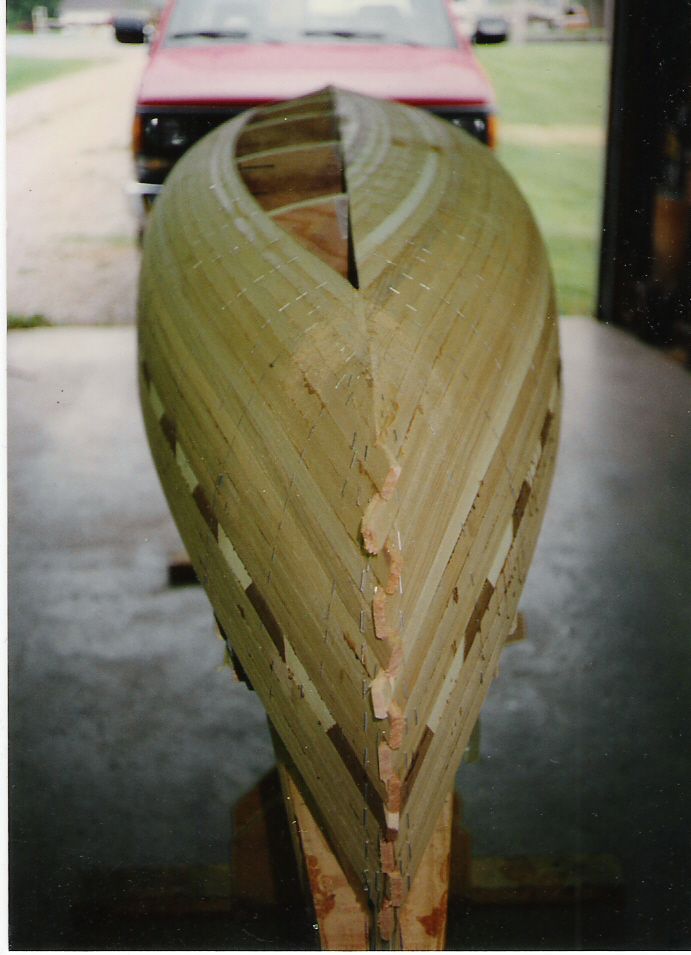-
Happy Birthday, Verlen Kruger (1922-2004)! 🍺🌎💿
You are using an out of date browser. It may not display this or other websites correctly.
You should upgrade or use an alternative browser.
You should upgrade or use an alternative browser.
Video: Nick Schade instructional for bending laminated stems on strip canoe
- Thread starter Kilt
- Start date
I'd go with laminating, like Nick, if I was going to build with stems !
I won't.
I paddled with Nick Schade, a fellow Nutmegger, about 22 years ago in Cobscook Bay, Maine, and Campobello Island, New Brunswick. I don't think anyone has more experience building strip kayaks and other small boats than he does.
Jim Dodd, or anyone, what are the pluses and minuses of building a strip canoe with or without stems? I've never had a strip canoe and never thought about the issue. Also, how do you complete the ends of the canoe if there are no stems at least on the inside?
I like the look of outside stems on a wood/canvas canoe.
Building with stems is more difficult because of the extra steps involved. They do look nice though!
I don't think there's any real strength difference between the two so it really comes down to personal preference.
I don't think there's any real strength difference between the two so it really comes down to personal preference.
Glenn
Nick is the Man ! I consider him the best source for building, specially kayaks. His methods work great with canoes also !
We differ on a few points, but that's OK !
As jffdejongh states, it's a personal preference.
To me stems are a waste of time, especially these days with epoxy.
All my canoes are Stemless, they have taken more abuse than normal, and have stood up fine !
Stems are a throwback to the building methods of the wood canvas days.
Some stemless pics, that I hope show how I trim the strip ends. This is not a canoe, just a mock up of how to do it..
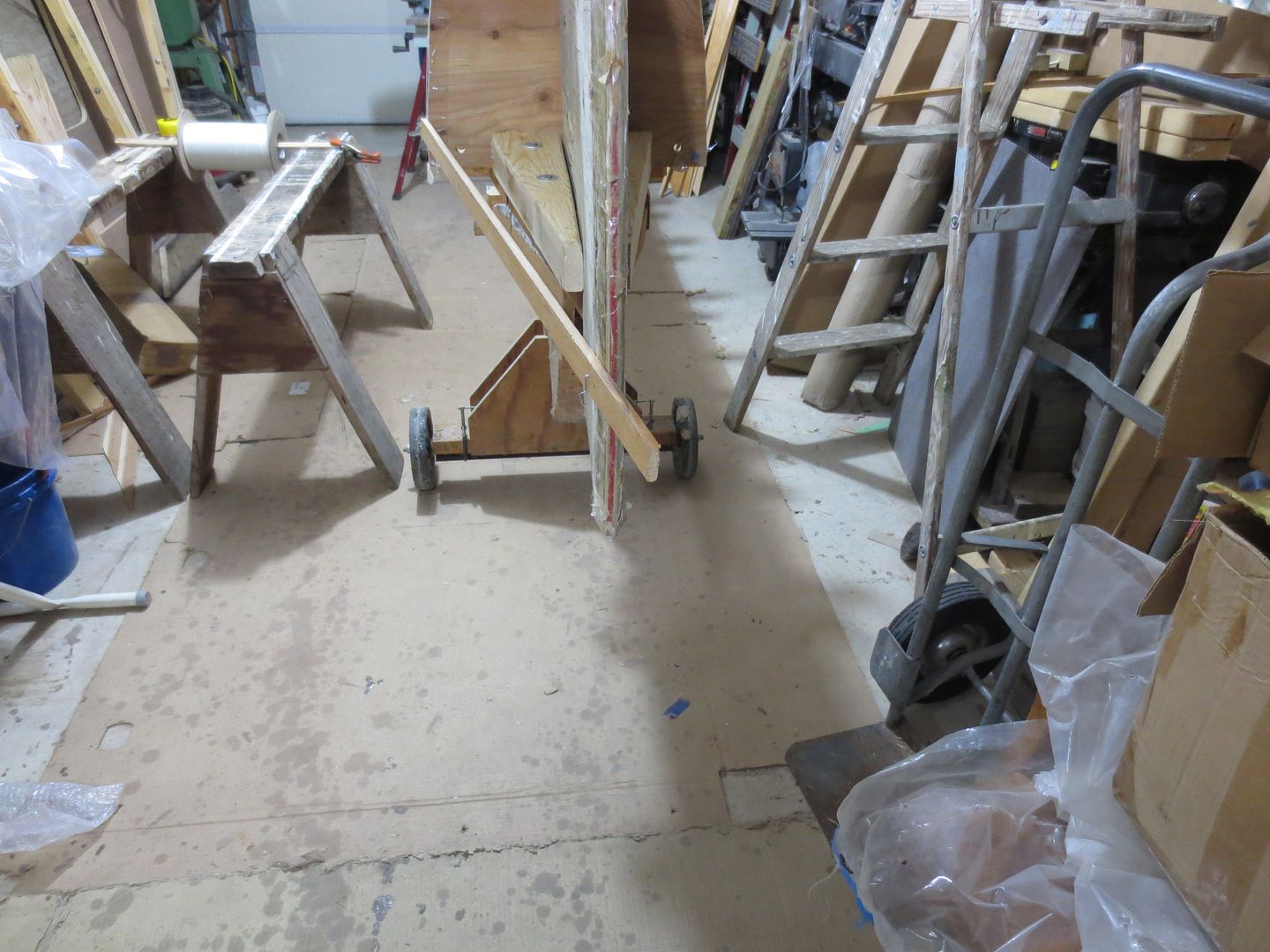
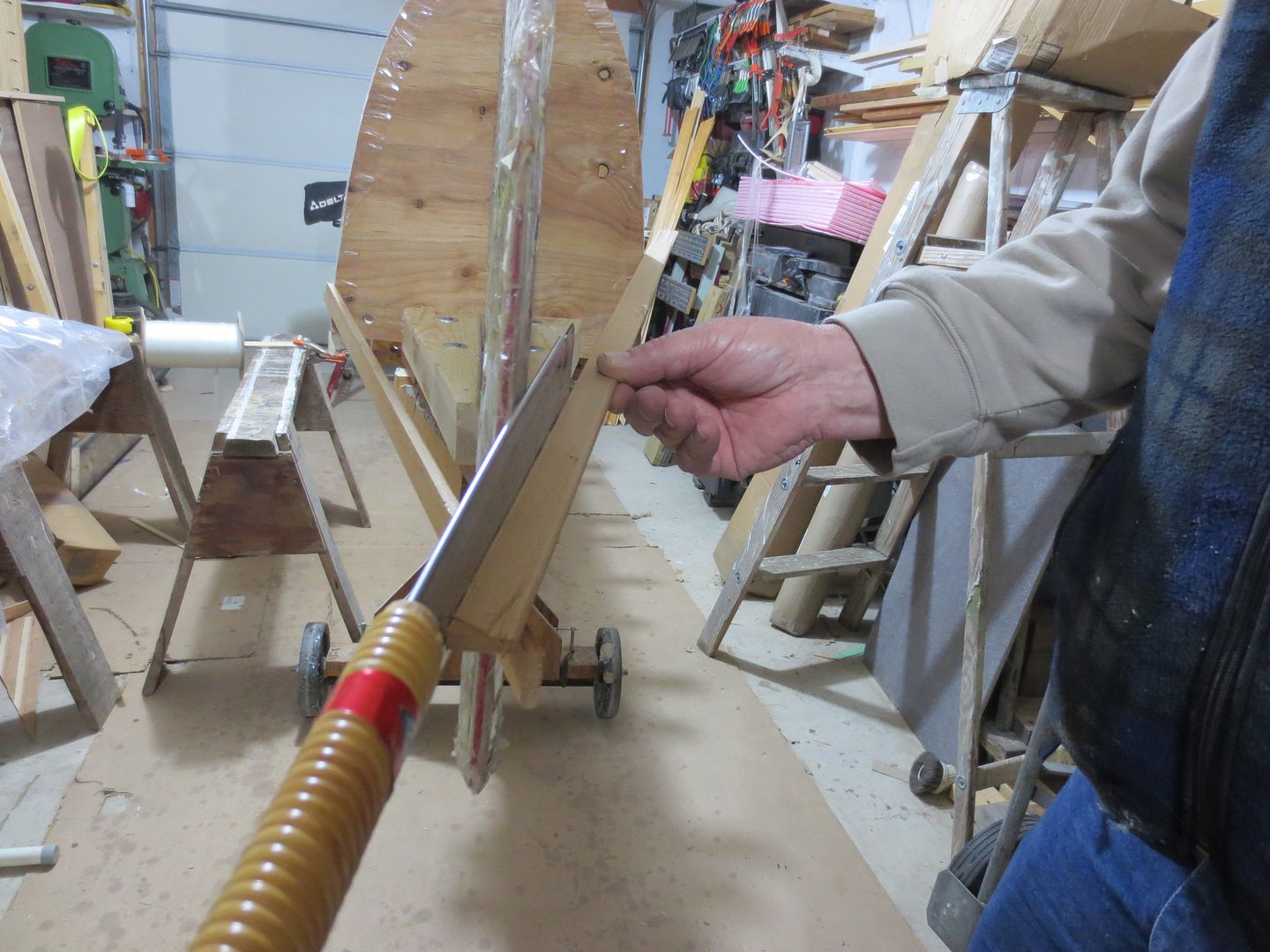





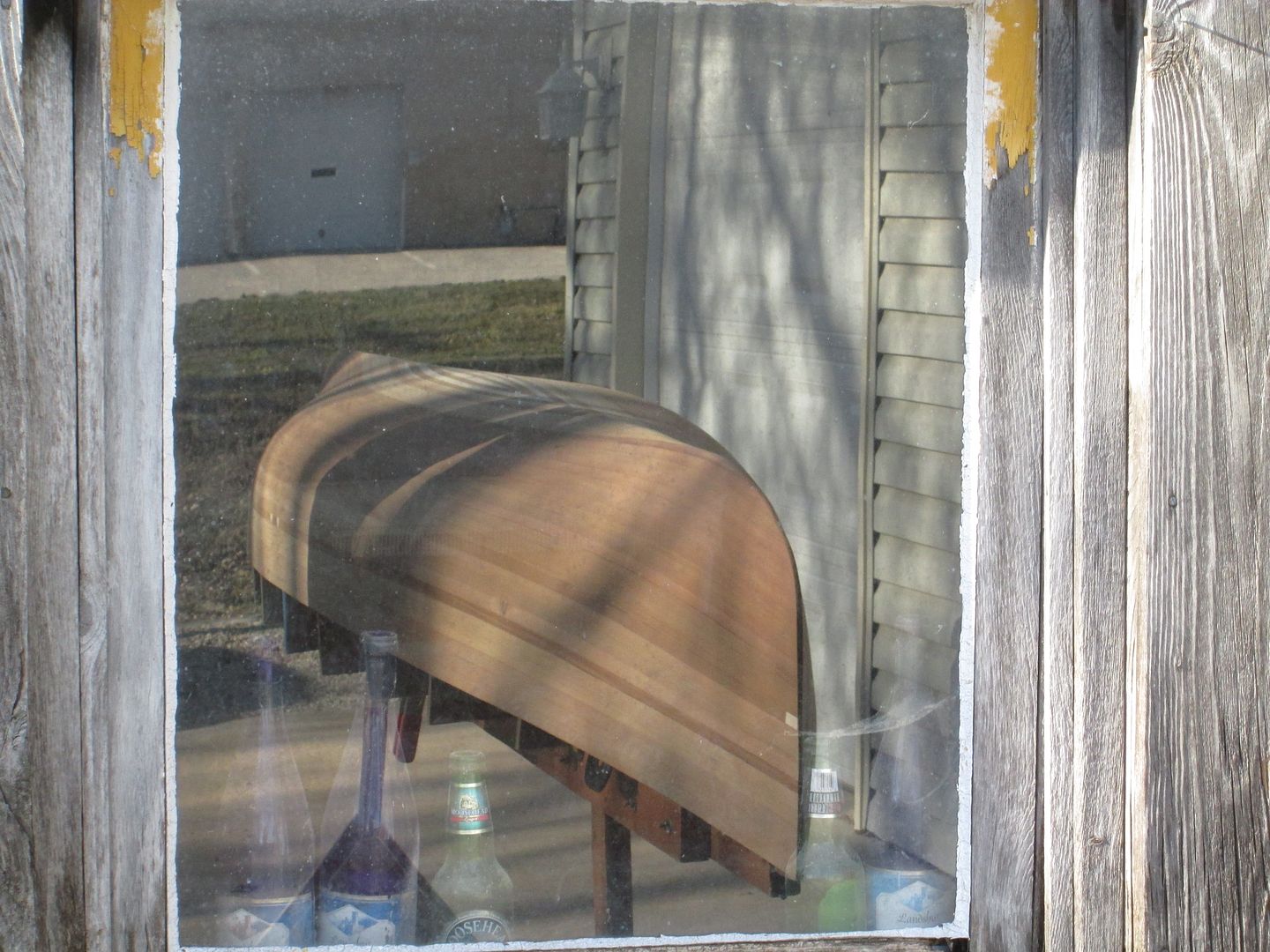
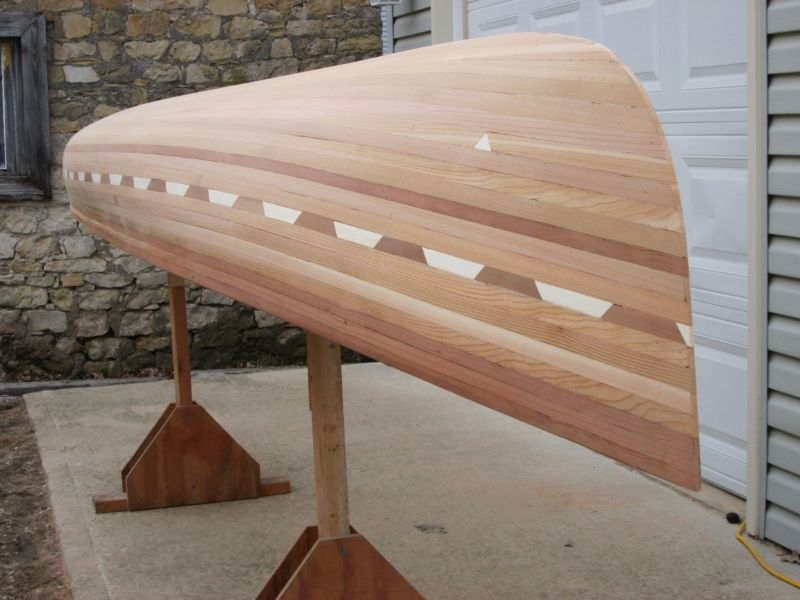
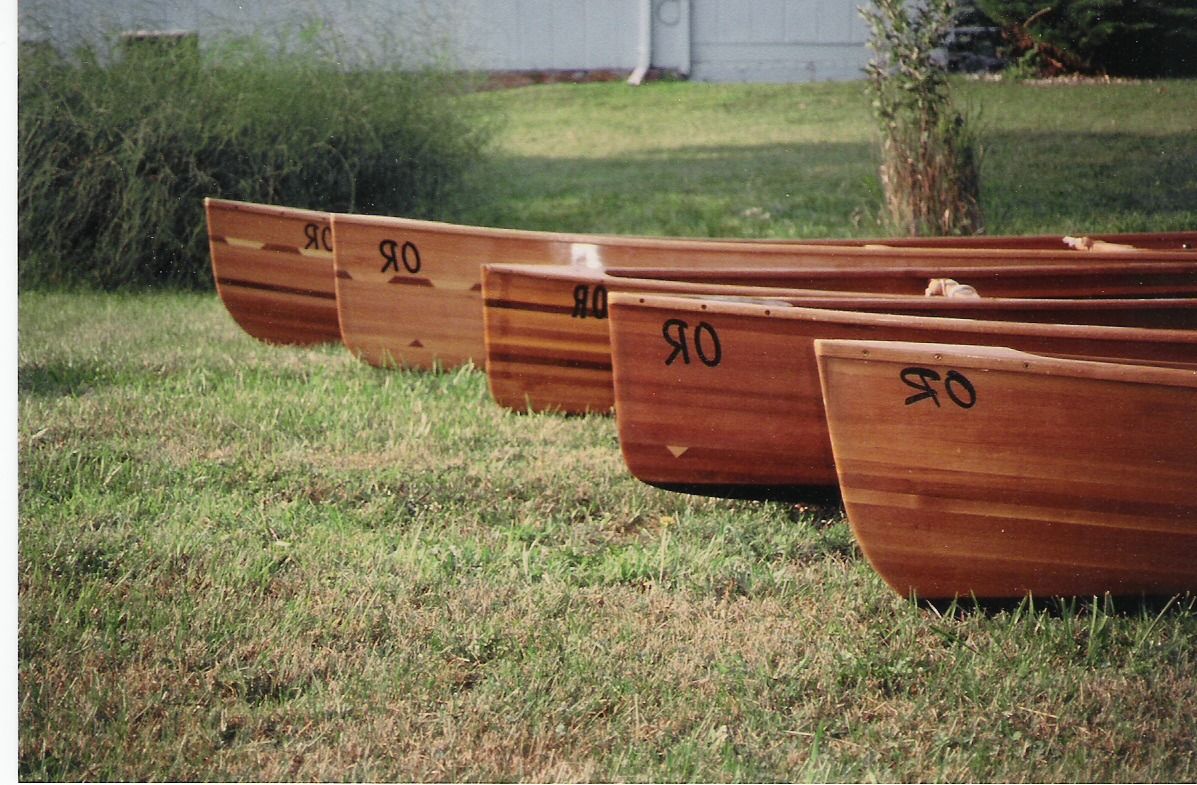
Nick is the Man ! I consider him the best source for building, specially kayaks. His methods work great with canoes also !
We differ on a few points, but that's OK !
As jffdejongh states, it's a personal preference.
To me stems are a waste of time, especially these days with epoxy.
All my canoes are Stemless, they have taken more abuse than normal, and have stood up fine !
Stems are a throwback to the building methods of the wood canvas days.
Some stemless pics, that I hope show how I trim the strip ends. This is not a canoe, just a mock up of how to do it..










Last edited:
I do almost everything exactly the same way as demonstrated, except I use 1/4 inch strips and I steam them. However, after watching that nifty little work around, I think I will try the 1/8 inch non steam method for the next canoe. Glueing and shaping the stems at the same time saves a lot of time.
As for stem vs stemless, well it's hard to put that brass stem band on a stemless canoe, and that's always the finishing touch that sets the whole right for me.
As for stem vs stemless, well it's hard to put that brass stem band on a stemless canoe, and that's always the finishing touch that sets the whole right for me.
Any pics where the ends curve towards the bilge Jim? Planning next build and going to try stemless I think, the lower area makes sense, but I would like a better idea how it changes as you round to the bottom.
Brian
Brian
So ... it looks like once you hit that one strip that starts to really roll over, you start fitting the edges together .... as opposed to using an external stem where you don't worry about that till the end of the stem area.
Good shots, thanks for posting.
Brian
Good shots, thanks for posting.
Brian
The boats I have completed to date have all been with stems (and no staples/nails), I picked up lumber last week for the next build, which I plan on doing stemless. The stemless option has been in the back of my mind for the last two builds and I have pondered over the differences for quite awhile.
While I do believe there will be no significant operational difference, I also don't expect it will be easier nor take less time.
Obviously, one the main differences is that you make stems for a stemmed build .... either by lamination as Nick demonstrates or by steam bending. On the stemmless side, you still need an inner stem or at least a surrogate inner stem, by either adding or modifying the stem/bow form to account for the presence of an inner stem. This is a point that doesn't get mentioned, so while you don't make stems, you still need to make allowance for the presence of an inner stem. So on the stemmed build, inner and outter stems are made and bent as pairs, on a stemless build allowance must be made to include the equivalent of an inner stem.
Setting the forms and prepping for stripping, is pretty much identical for both methods .... the stem/bow forms will be fitted with, or have allowance made (stemless) when cut, for the presence of an inner stem. Both methods then require the correct angle of contact (for the strips) to be cut into the inner stem ... the difference between the two methods here is where the strips attach (either to the stem or just beyond to each other). The stemless build will require the inner stem area to be taped after shaping, so that is one extra step required for the stemless build.
Setting the first strips is again pretty much the same, except the stemless build will require mechanical (staple/nail,screw) to affix the first strip and the stemmed will be glued to the inner stem. The second strip (other side) stemless will again need mechanical, then the correct angle will need to be cut at the correct length to fit with the first strip and then be glued to the first strip, while the stemmed will be glued to the inner stem. So the stemless method will require the extra precision cut, while the stemmed is simply glued with a bit of excess strip.
After the first strips are set, applying strips is the same, but attaching them at the ends remains different, in that with each pair attached with the stemless method, one will require the precise cut to allow gluing to its neighbour strip. On the stemmed build, the strip is simply cut about 1/2" long and attached. If using the "Minnesota" stemless style (as Jim does) then an additional step of using a rat tail rasp to create a cove for the next strip layer will be required. It is useful to think of attaching the Minnesota style strips in pairs, requiring an alternating precise cut and filing a cove for each pair. So, at this point attaching pairs of strips in the stemless style has more operations.
Once you get to the turn at the bilge, stripping changes a little at the ends (bow/stern) ... the strips are are starting roll over and how these are handled is a bit different for each style. In the stemmed build, the end of the inner stem is marked and strips are still attached to the inner stem, but are simply cut a little short of center, leaving a sloppy joint line along the inner stem area. A channel will be chiselled here to accept the outter stem, so there is no need for precision.
The stemless build will require each strip at this point to be cut exactly on the center and matched to it's neighbour.
Each build is unique, but for example purposes, lets say that this turn at the build stage/region requires 15 pairs of strips .... so the differences are that there are 15 matched center joints in the stemless build and 15 pairs of "just short" joints on the stemmed build. The matched center joints are signifcantly more labour and time consuming than the "just short" joints.
Completing the hull from this point of is identical in either case, so no difference in stripping after the turn at the bilge.
Finishing the ends requires trimming the strips at the end to be flush with the stem profile. In the case of stemless, this is just trimming the side of each pair that wasn't cut for fit.
The stemmed build requires the strips to be cut back to the stem profile as well, plus lightly sanded to match the profile. The outter stem gets tapered at the bottom and a channel is cut to the inner stem to accept the outter stem. The outter stem is then epoxied in place.
Fitting the outter stem is one of the biggest differences in a stemless vs stemmed build. Trimming strips to the profile is about the same effort, but additional steps are required to taper and fit the outter stem, then the step to epoxy it in place. IMO, this is the one major difference in the build method and for an experienced builder I would estimate it takes about 4-5 hours to do the entire outter stem process.
At this point, each stem is ready for final shaping ... the stemless will require less work as it is just a levelling and rounding of the end, on softwood. The stemmed build will require an additional shaping to get the attached square outter stem ... this is straightforward removal of wood to extend the hull shape/line through the outter stem, but it is hard wood and takes a little bit of work.
The need to attach the outter stem is the single major difference in time and effort between the 2 build types IMO. Likely accounting for some ~ 6 hours or so of build time.
Through all of those steps and differences, the 2 major items in the build types appears to be 1) attachment of outter stems and initial shaping using the stemmed build 2) the extra fitting required for the stemless build in the turn of the bilge area. The question of which takes longer and does the resulting difference actually have any significant impact on the build is a something that doesn't appear to be as cut and dried as some comments would suggest.
When discussing things like this, I find it useful to keep in mind the final purpose. It reminds me of a discussion on suitable glues for applying the strips ... it invariably comes down to using the "best/strongest/expensive" glue and while there is no question that the glues have varying strengths, the argument that a stronger glue is better is nonsense for attaching strips. The actual strength of the softwoods (most commonly used) is so low that almost any glue joint will be stronger than the surrounding wood.
In this case, I believe that either method will provide suitable results for routine use .... further, I will suggest that there doesn't appear to be enough significant differences in the two processes to yield any significant differences in build time required from an overall build time perspective. The build this winter will be stemless, so that will give experience with both types and no doubt I will comment on the differences in that build thread ... but for now I don't expect any significant difference to the build time.
It seems that the comment "it is mostly a personal preference" may just be the closest to reality in this case .... and if you subscribe to that idea, don't add qualifiers to the statement and ruin it.
Brian
While I do believe there will be no significant operational difference, I also don't expect it will be easier nor take less time.
Obviously, one the main differences is that you make stems for a stemmed build .... either by lamination as Nick demonstrates or by steam bending. On the stemmless side, you still need an inner stem or at least a surrogate inner stem, by either adding or modifying the stem/bow form to account for the presence of an inner stem. This is a point that doesn't get mentioned, so while you don't make stems, you still need to make allowance for the presence of an inner stem. So on the stemmed build, inner and outter stems are made and bent as pairs, on a stemless build allowance must be made to include the equivalent of an inner stem.
Setting the forms and prepping for stripping, is pretty much identical for both methods .... the stem/bow forms will be fitted with, or have allowance made (stemless) when cut, for the presence of an inner stem. Both methods then require the correct angle of contact (for the strips) to be cut into the inner stem ... the difference between the two methods here is where the strips attach (either to the stem or just beyond to each other). The stemless build will require the inner stem area to be taped after shaping, so that is one extra step required for the stemless build.
Setting the first strips is again pretty much the same, except the stemless build will require mechanical (staple/nail,screw) to affix the first strip and the stemmed will be glued to the inner stem. The second strip (other side) stemless will again need mechanical, then the correct angle will need to be cut at the correct length to fit with the first strip and then be glued to the first strip, while the stemmed will be glued to the inner stem. So the stemless method will require the extra precision cut, while the stemmed is simply glued with a bit of excess strip.
After the first strips are set, applying strips is the same, but attaching them at the ends remains different, in that with each pair attached with the stemless method, one will require the precise cut to allow gluing to its neighbour strip. On the stemmed build, the strip is simply cut about 1/2" long and attached. If using the "Minnesota" stemless style (as Jim does) then an additional step of using a rat tail rasp to create a cove for the next strip layer will be required. It is useful to think of attaching the Minnesota style strips in pairs, requiring an alternating precise cut and filing a cove for each pair. So, at this point attaching pairs of strips in the stemless style has more operations.
Once you get to the turn at the bilge, stripping changes a little at the ends (bow/stern) ... the strips are are starting roll over and how these are handled is a bit different for each style. In the stemmed build, the end of the inner stem is marked and strips are still attached to the inner stem, but are simply cut a little short of center, leaving a sloppy joint line along the inner stem area. A channel will be chiselled here to accept the outter stem, so there is no need for precision.
The stemless build will require each strip at this point to be cut exactly on the center and matched to it's neighbour.
Each build is unique, but for example purposes, lets say that this turn at the build stage/region requires 15 pairs of strips .... so the differences are that there are 15 matched center joints in the stemless build and 15 pairs of "just short" joints on the stemmed build. The matched center joints are signifcantly more labour and time consuming than the "just short" joints.
Completing the hull from this point of is identical in either case, so no difference in stripping after the turn at the bilge.
Finishing the ends requires trimming the strips at the end to be flush with the stem profile. In the case of stemless, this is just trimming the side of each pair that wasn't cut for fit.
The stemmed build requires the strips to be cut back to the stem profile as well, plus lightly sanded to match the profile. The outter stem gets tapered at the bottom and a channel is cut to the inner stem to accept the outter stem. The outter stem is then epoxied in place.
Fitting the outter stem is one of the biggest differences in a stemless vs stemmed build. Trimming strips to the profile is about the same effort, but additional steps are required to taper and fit the outter stem, then the step to epoxy it in place. IMO, this is the one major difference in the build method and for an experienced builder I would estimate it takes about 4-5 hours to do the entire outter stem process.
At this point, each stem is ready for final shaping ... the stemless will require less work as it is just a levelling and rounding of the end, on softwood. The stemmed build will require an additional shaping to get the attached square outter stem ... this is straightforward removal of wood to extend the hull shape/line through the outter stem, but it is hard wood and takes a little bit of work.
The need to attach the outter stem is the single major difference in time and effort between the 2 build types IMO. Likely accounting for some ~ 6 hours or so of build time.
Through all of those steps and differences, the 2 major items in the build types appears to be 1) attachment of outter stems and initial shaping using the stemmed build 2) the extra fitting required for the stemless build in the turn of the bilge area. The question of which takes longer and does the resulting difference actually have any significant impact on the build is a something that doesn't appear to be as cut and dried as some comments would suggest.
When discussing things like this, I find it useful to keep in mind the final purpose. It reminds me of a discussion on suitable glues for applying the strips ... it invariably comes down to using the "best/strongest/expensive" glue and while there is no question that the glues have varying strengths, the argument that a stronger glue is better is nonsense for attaching strips. The actual strength of the softwoods (most commonly used) is so low that almost any glue joint will be stronger than the surrounding wood.
In this case, I believe that either method will provide suitable results for routine use .... further, I will suggest that there doesn't appear to be enough significant differences in the two processes to yield any significant differences in build time required from an overall build time perspective. The build this winter will be stemless, so that will give experience with both types and no doubt I will comment on the differences in that build thread ... but for now I don't expect any significant difference to the build time.
It seems that the comment "it is mostly a personal preference" may just be the closest to reality in this case .... and if you subscribe to that idea, don't add qualifiers to the statement and ruin it.
Brian
In this case, I believe that either method will provide suitable results for routine use .... further, I will suggest that there doesn't appear to be enough significant differences in the two processes to yield any significant differences in build time required from an overall build time perspective.
Brian, that was a very informative discourse, especially for someone like me who is a non-builder but curious as to the process. I have two classes of other questions as to the different methods.
Does either method provide a strength difference in the stem area, or any other performance difference for the canoe, or an ease of repair difference for the bow/stern areas?
Is there a significant difference in the fiberglassing of the outside or inside stem areas as between the two methods? And how usually does one glass the inside stem area? Try to fold one big sheet in there? Or put one narrow strip of glass or glass tape right in the nose, joined to sheets coming from the two sides? Or what?
Thanks Glenn ...
As far repairs go, broke is broke and each one is a little different .... I don't believe either one is more susceptible in general use.
One small potential for performance gain, with stemless, is that I believe you can achieve a finer entry angle, so that maybe it cuts the water a little cleaner ....
On the outside, there are several ways to finish the ends, but they use the same or similar methods. The glass extending from the body over the ends will not bend to make the tight turns for overlap, typically, narrower strips (3" 4") are cut on a bias and are applied either before or after the main sheet is applied to the hull. The bias cut conforms quite easily to the shape round at the nose and completes the waterproof shell to that area.
There is no functional difference in glass application between a stemless or stemmed build.
The inside application is again almost identical, the FG sheet will be the exact same size, with the only difference being that you cut the sheet at the bilge area so that it tucks neatly to the stem(in a stemmed build) and obviously this isn't required in stemless ... further in the stem blends into the strips.
My understanding is that on the inside, you do the fitting to "near" the end and call it a day. Add bias strips or fillets in this region really doesn't add much additional strength, but can add weight and add to the finishing work.
All of this assumes a normal/routine build strategy, there are exceptions to these general statements ... you can add an outter stem to a stemless build, add a brass ban, add skid plates ....there are lots of other build methods, but for the middle ground I believe this a reasonable accurate portrayal.
Brian
There in lies the rub .... the strength comes from the composite you form with the fiberglass/epoxy and the strip core. So the glue and wood core are not the main players in the strength game ... you may be able to argue in specific circumstances, that there is an small advantage to one or the other, but generally I believe the correct response is that both provide the strength required to do the job.Does either method provide a strength difference in the stem area, or any other performance difference for the canoe, or an ease of repair difference for the bow/stern areas?
As far repairs go, broke is broke and each one is a little different .... I don't believe either one is more susceptible in general use.
One small potential for performance gain, with stemless, is that I believe you can achieve a finer entry angle, so that maybe it cuts the water a little cleaner ....
This is only my take/opinion, but there is very little difference, once the hull has been shaped and prepared.Is there a significant difference in the fiberglassing of the outside or inside stem areas as between the two methods? And how usually does one glass the inside stem area? Try to fold one big sheet in there? Or put one narrow strip of glass or glass tape right in the nose, joined to sheets coming from the two sides? Or what?
On the outside, there are several ways to finish the ends, but they use the same or similar methods. The glass extending from the body over the ends will not bend to make the tight turns for overlap, typically, narrower strips (3" 4") are cut on a bias and are applied either before or after the main sheet is applied to the hull. The bias cut conforms quite easily to the shape round at the nose and completes the waterproof shell to that area.
There is no functional difference in glass application between a stemless or stemmed build.
The inside application is again almost identical, the FG sheet will be the exact same size, with the only difference being that you cut the sheet at the bilge area so that it tucks neatly to the stem(in a stemmed build) and obviously this isn't required in stemless ... further in the stem blends into the strips.
My understanding is that on the inside, you do the fitting to "near" the end and call it a day. Add bias strips or fillets in this region really doesn't add much additional strength, but can add weight and add to the finishing work.
All of this assumes a normal/routine build strategy, there are exceptions to these general statements ... you can add an outter stem to a stemless build, add a brass ban, add skid plates ....there are lots of other build methods, but for the middle ground I believe this a reasonable accurate portrayal.
Brian
I helped a friend that was glassing the inside of a Stemmed canoe. It was quite fiddly getting the wetted glass, in and around the inner stem.
You really need to seal the stems, keeping moisture out.
If you are concerned about the strength of a Stemless build ? Simply add a fillet of thickened epoxy, before glassing.
It's easy to shape that fillet, so glassing over it is easy, and water tight.
I have only added a fillet to one of my early canoes.
It's really not necessary.
My stems have 4 layers of cloth, on the outside , where the stems get the most abuse.
Main layer, Football layer, and two bias strips.
They are hard to see, but add strength as well as abrasion resistance.
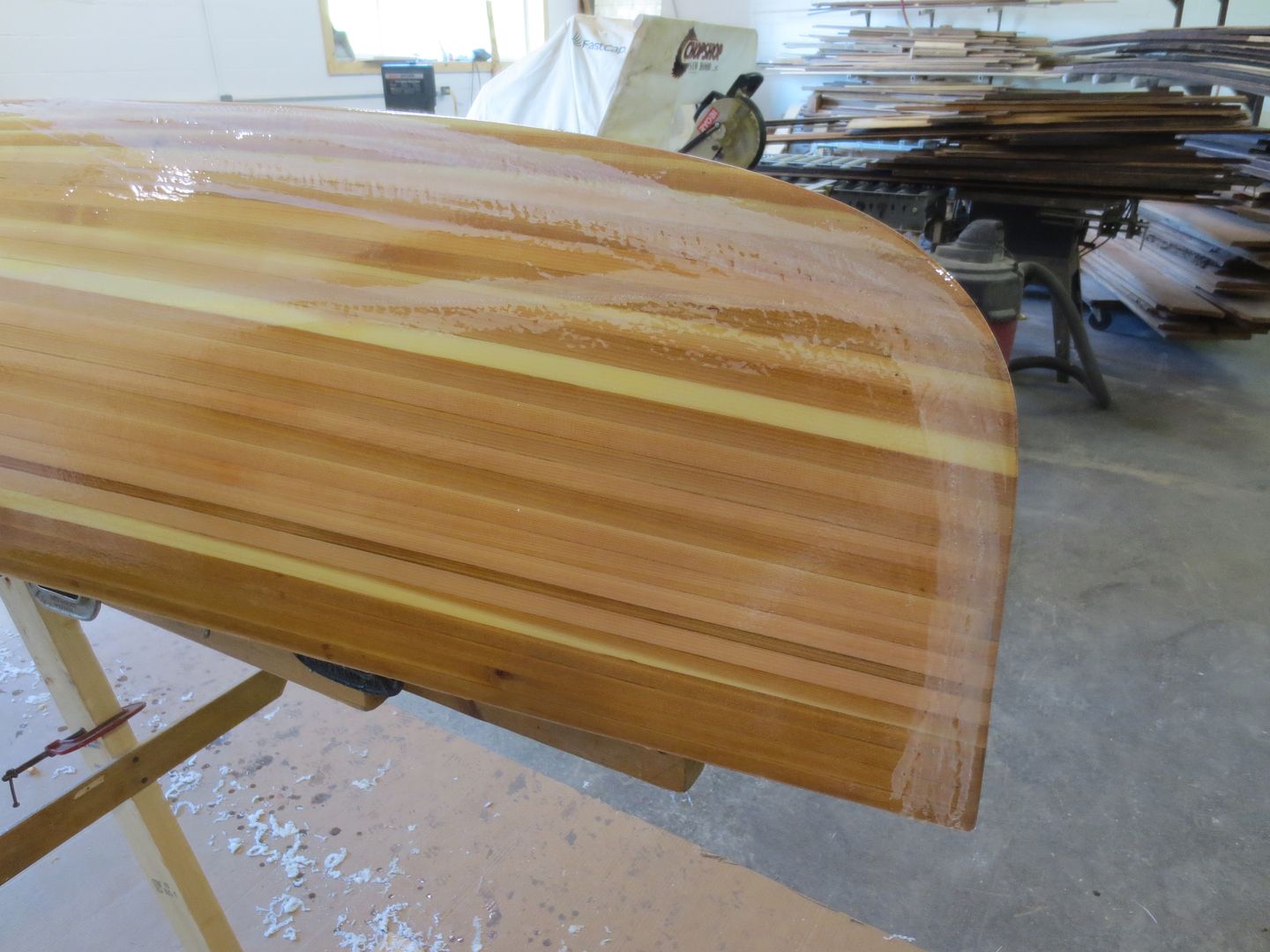
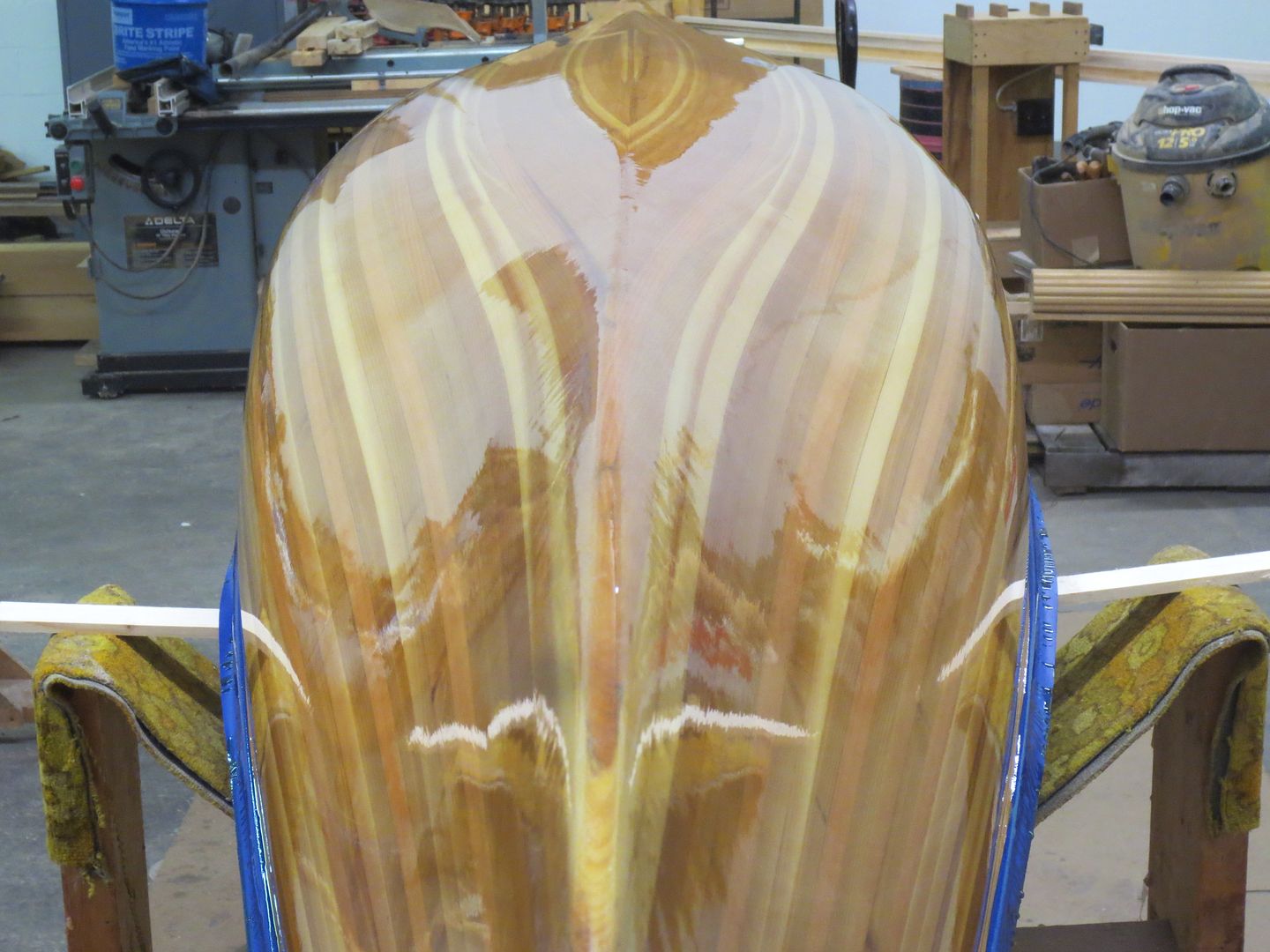
You really need to seal the stems, keeping moisture out.
If you are concerned about the strength of a Stemless build ? Simply add a fillet of thickened epoxy, before glassing.
It's easy to shape that fillet, so glassing over it is easy, and water tight.
I have only added a fillet to one of my early canoes.
It's really not necessary.
My stems have 4 layers of cloth, on the outside , where the stems get the most abuse.
Main layer, Football layer, and two bias strips.
They are hard to see, but add strength as well as abrasion resistance.


I'm sure I'm much more of a wood butcher than Cruiser, but the application of the external stems for me does not take much time. To begin with, I never use hardwood for the external stems anymore, just cedar. As I plank, I usually try to cut the strips fair on the internal stem so the channel is more or less intact, it's not something I need to deal with after I'm finished planking. I never use epoxy on the external either, just regular wood glue. A rough calculation would be.....cutting external stems on bandsaw...5 minutes. Hand plane to fit...5 to ten minutes for both. Slap the glue on and then I use tie down straps to cinch it down...maybe 20 minutes to a half hour for both. Because I use cedar, shaping the outer stem after the glue is dry takes about 15 minutes per stem. I would say somewhere between an hour or two for my outside stems.
This is what makes Nick's process so intriguing....when I steam my stems, I let them pre-soak for a day or two, then steam them for about a half an hour and then clamp them. Then I let them dry for two or three days before I glue them, which is a fair bit more messy when they are already bent, as compared to Nicks method.
So using Nick's method, I actually would save two or three days of wait time, plus a whole lot of set up time, with the steamer and the soaking and all that jazz. I'm certainly going to give it a try.
This is what makes Nick's process so intriguing....when I steam my stems, I let them pre-soak for a day or two, then steam them for about a half an hour and then clamp them. Then I let them dry for two or three days before I glue them, which is a fair bit more messy when they are already bent, as compared to Nicks method.
So using Nick's method, I actually would save two or three days of wait time, plus a whole lot of set up time, with the steamer and the soaking and all that jazz. I'm certainly going to give it a try.
The beauty and hell of trying to describe building your own canoe is that each person can completely tailor each build to their own experience, thinking and knowledge. The best that can done is to read the basics from the likes of Moore/Schade/Gilpatrick and then leverage your own experience and adapt a technique, so that it works with available tools/experience.
Mem .. when I am planning to steam, it is wait time for the wood, but not the project ... typically there's enough to do that it it sits on the side and other steps get done, so no real impact on build. When steaming softwood I find a presoak helps, but it seems for me 20 minutes is lots of time. My theory is that the wood needs to stay hot if it is to bend properly and dry softwood has very little mass to hold the heat, so it cools quickly, not really giving time to get a bend done, the water you add by soaking increases that mass and helps keep the wood hotter, longer. We think of steam as being wet, but when a steamer is "up to temp" the steam heating is actually quite dry.
As far as just laminating the stems (per Nick), that is pretty doable as long as the bend doesn't get too sharp (i.e. Freedom 17). Personally, I would forego the palatizing tape, it may stop the drips, but I am reasonably certain it will also interfere with the glue setting up as well. Some of that spring back in the video is likely the glued layers starting to shift, you can see that some of the glue is still wet when he removes it and notice how quick it goes back onto the form to fully setup, without the tape. I think one step that is understated but is quite important, is the addition of the second set of clamps to keep the strips from shifting sideways. Those clamps need to be snugged up before you tighten the main bending clamps, they save a lot of edge cleanup work.
I have a question for the other builders here concerning the inside glass, specifically fitting the ends, regardless of stem choice, fitting at the end always seems a bit fiddly to me.
On the next build, after the exterior glass is done and before I release the canoe from the forms ... my intention is to layout the glass on the exterior and cut the appropriate stem profiles, using the exterior stem profile as a guide (reducing edge by around 3/4"). In theory, this seems like a reasonable way to get the glass cut to the right shape to fit into the stem recesses.
If anyone has tried this or has thoughts I would appreciate the feedback ....
Brian
Mem .. when I am planning to steam, it is wait time for the wood, but not the project ... typically there's enough to do that it it sits on the side and other steps get done, so no real impact on build. When steaming softwood I find a presoak helps, but it seems for me 20 minutes is lots of time. My theory is that the wood needs to stay hot if it is to bend properly and dry softwood has very little mass to hold the heat, so it cools quickly, not really giving time to get a bend done, the water you add by soaking increases that mass and helps keep the wood hotter, longer. We think of steam as being wet, but when a steamer is "up to temp" the steam heating is actually quite dry.
As far as just laminating the stems (per Nick), that is pretty doable as long as the bend doesn't get too sharp (i.e. Freedom 17). Personally, I would forego the palatizing tape, it may stop the drips, but I am reasonably certain it will also interfere with the glue setting up as well. Some of that spring back in the video is likely the glued layers starting to shift, you can see that some of the glue is still wet when he removes it and notice how quick it goes back onto the form to fully setup, without the tape. I think one step that is understated but is quite important, is the addition of the second set of clamps to keep the strips from shifting sideways. Those clamps need to be snugged up before you tighten the main bending clamps, they save a lot of edge cleanup work.
I have a question for the other builders here concerning the inside glass, specifically fitting the ends, regardless of stem choice, fitting at the end always seems a bit fiddly to me.
On the next build, after the exterior glass is done and before I release the canoe from the forms ... my intention is to layout the glass on the exterior and cut the appropriate stem profiles, using the exterior stem profile as a guide (reducing edge by around 3/4"). In theory, this seems like a reasonable way to get the glass cut to the right shape to fit into the stem recesses.
If anyone has tried this or has thoughts I would appreciate the feedback ....
Brian
That is how I do it.On the next build, after the exterior glass is done and before I release the canoe from the forms ... my intention is to layout the glass on the exterior and cut the appropriate stem profiles, using the exterior stem profile as a guide (reducing edge by around 3/4"). In theory, this seems like a reasonable way to get the glass cut to the right shape to fit into the stem recesses.
If anyone has tried this or has thoughts I would appreciate the feedback ....
Brian
If I cut it a little long, no problem, as I wet out one side, then lay it in. Usually with a tapered scrap strip, then to the opposite side and tuck it in.
I always save the stems for last, as it's easy to get delayed, when you should be wetting out the rest of the hull.
Similar threads
- Replies
- 4
- Views
- 855
- Replies
- 149
- Views
- 16K
- Replies
- 15
- Views
- 2K


